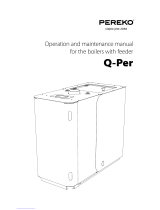
2
General Information
TABLE OF CONTENTS
1 GENERAL INFORMATION ............................................................................................................................................................................... 3
1.1 Symbols used in the manual ........................................................................................................................................................................ 3
1.2 Appropriate use of appliance ...................................................................................................................................................................... 3
1.3 Water treatment ............................................................................................................................................................................................ 3
1.4 Information for user or system manager ..................................................................................................................................................... 3
1.5 Safety warnings ........................................................................................................................................................................................... 4
1.6 Technical data plate ...................................................................................................................................................................................... 5
1.7 General warnings ......................................................................................................................................................................................... 6
2 TECHNICAL FEATURES AND DIMENSIONS ................................................................................................................................................ 7
2.1 Technical features ........................................................................................................................................................................................ 7
2.2 Main components .......................................................................................................................................................................................... 7
2.3 Dimensions .................................................................................................................................................................................................... 8
2.4 Operating data as per UNI 10348............................................................................................................................................................... 13
3 INSTALLATION INSTRUCTIONS .................................................................................................................................................................. 14
3.1 General warnings...................................................................................................................................................................................... 14
3.2 Installation standards ................................................................................................................................................................................ 15
3.3 Handling ...................................................................................................................................................................................................... 16
3.4 Positioning in boiler room........................................................................................................................................................................... 16
3.5 Burner ........................................................................................................................................................................................................ 16
3.5.1 Choosing the burner ....................................................................................................................................................................... 16
3.5.2 Installing the burner......................................................................................................................................................................... 17
3.6 Connecting flame control warning light to burner ................................................................................................................................... 17
3.7 Flue connection ......................................................................................................................................................................................... 18
3.8 Condensation drainage ............................................................................................................................................................................. 18
3.9 Furnace door: adjustment, opening, closing............................................................................................................................................ 19
3.9.1 TRISTAR 3G 110÷TRISTAR 3G 380 boilers ..................................................................................................................................... 19
3.9.2 TRISTAR 3G 500÷TRISTAR 3G 840 boilers .................................................................................................................................... 19
3.9.3 TRISTAR 3G 1100÷TRISTAR 3G 3000 boilers ................................................................................................................................. 20
3.9.4 Important note ................................................................................................................................................................................... 20
3.10 Connecting boiler to system ..................................................................................................................................................................... 21
3.10.1 Recirculation pump........................................................................................................................................................................ 21
3.11 Filling the system ........................................................................................................................................................................................ 21
3.12 Connecting gas .......................................................................................................................................................................................... 22
3.13 Packaging ................................................................................................................................................................................................... 23
3.14 Assembling casing ..................................................................................................................................................................................... 24
3.15 Electrical connections ............................................................................................................................................................................... 32
3.16 Standard panel board ................................................................................................................................................................................ 33
3.17 Hydraulic and electrical system connection ............................................................................................................................................ 34
3.18 Optional panel board ................................................................................................................................................................................. 36
3.19 Layout of probe connection on heating controller .................................................................................................................................. 37
3.20 Programming the heating controller .......................................................................................................................................................... 37
3.21 Hydraulic and electric system connection with optional panel board .................................................................................................... 40
3.22 Commissioning ........................................................................................................................................................................................... 42
3.23 Adjustment of burner ................................................................................................................................................................................ 43
4 INSPECTIONS AND MAINTENANCE ............................................................................................................................................................ 43
Inspection and maintenance instructions ......................................................................................................................................................... 43
Boiler body maintenance ................................................................................................................................................................................... 44
Maintenance of burner ...................................................................................................................................................................................... 44
Checking ignition electrode................................................................................................................................................................................ 44
Components to check during yearly inspection ............................................................................................................................................... 44
































